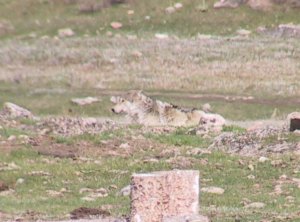As autumn begins, for the first time not only are all of the packs on the Yellowstone Park northern range large, they are all almost equal in size.
The Park pup count for the year is quite accurate and pup survival was high, but it is harder keep track of the adults, so with the possibility of being off 2 or 3, basically the situation is this: Druid Peak 20 wolves, Agate Creek 20 wolves, Oxbow Creek 20 wolves, Leopold 20 wolves, Slough Creek 20 wolves.
The Slough adults are all females except for one male born to the pack some time ago, and a brand new alpha male who came from the Agates. The previous Slough alpha, now decreased, had seized the opportunity to became the pack’s leading male while he was just a yearling because of the sex ratio imbalance. He killed about a month ago by a vehicle in the Park. He was quickly replaced by another yearling male from the nearby Agates. He is also uncollared and unnumbered. The older male in the Slough Creek pack is likely the son of the alpha female so that is why he has not advanced to alpha status. Field studies and especially genetic studies of Park wolves show they strongly avoid inbreeding. This was confirmed in the findings of the recently released ‘The genealogy and genetic viability of reintroduced Yellowstone grey wolves.” VonHoldt, et al. Molecular Ecology (2007).
To the south a bit, the Hayden Valley Pack remained visible to people all year with its 5 adults and 4 pups. Nine wolves is a substantial pack, but they have an overlapping territory with the larger Gibbon Park of 10-12 adults and 2-4 pups (good pup sightings were never made for this hard-to-see-pack). The Haydens are also in contention with the brawny bison-killing Mollies Pack (8-9 adults and 5 pups).
The Hayden Pack alpha pair have become about the most photographed wolves in the Park’s history. They are now both relatively old. In their territory they need to be able to kill bison to make it through the winter. In the summer there are elk plus a convenient carcass dump in the vicinity (for animals hit on the Park roads). I learned about the dump while wolf watching this summer from folks who had been following the pack.
Dr. Doug Smith told me that studies have shown that the ability for a wolf pack to kill bison is different than killing elk (where speed is an advantage, something more typical of female wolves). Successful bison-killing packs are like Mollies. They have a number of large, strong male wolves.
While I don’t have a run down on the rest of the Park’s packs, I want to mention the Bechler Pack because I had no information about them this year until today.
They continue to inhabit the SW corner of Yellowstone (Bechler Meadows), but they do sometimes leave that vicinity. Two weeks ago they were tracked near Lewis Lake. That’s interesting because an Idaho State University student trip to the backcountry in that area heard wolves howling. This is not usually a place you hear that.
The Bechler Pack has 10-12 adults and 4-5 pups.
The Park population is up for the second year in a row after the big crash, although the mid-year estimate of about 175 is probably an overestimate because the adult wolf count for mid-year was mostly based on that of late last winter.
Factoring in the Yellowstone Park wolf increase, we see that it accounts for much of the Wyoming increase at mid-year as reported by ED Bangs the other day.
Update: In one of the comments below Kathie Lynch adds detail to the 20-20-20-20-20 breakdown of the wolf packs on the northern range. She also adds detail about the Slough Creek Pack males and other Park wolves.

 Location
Location


